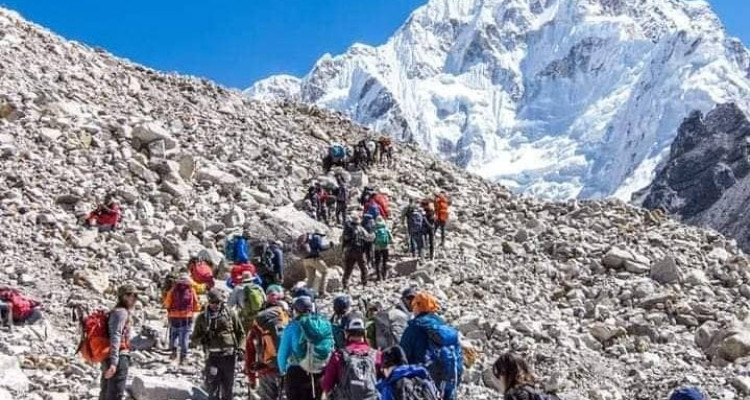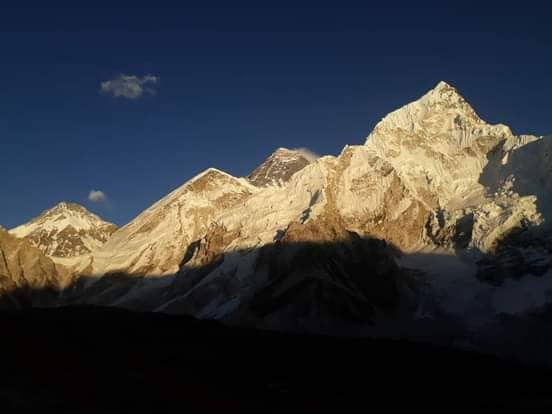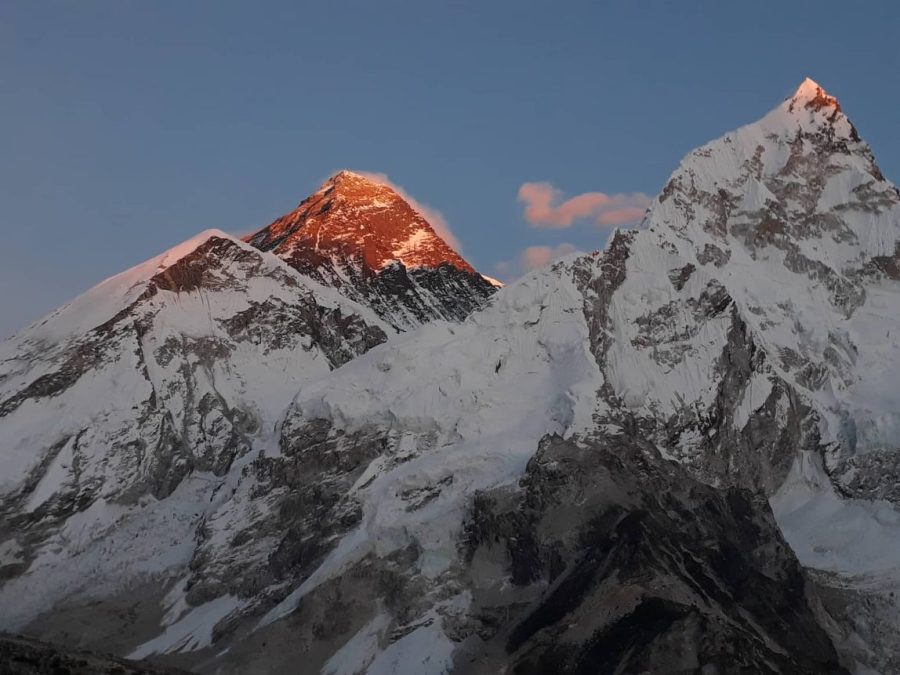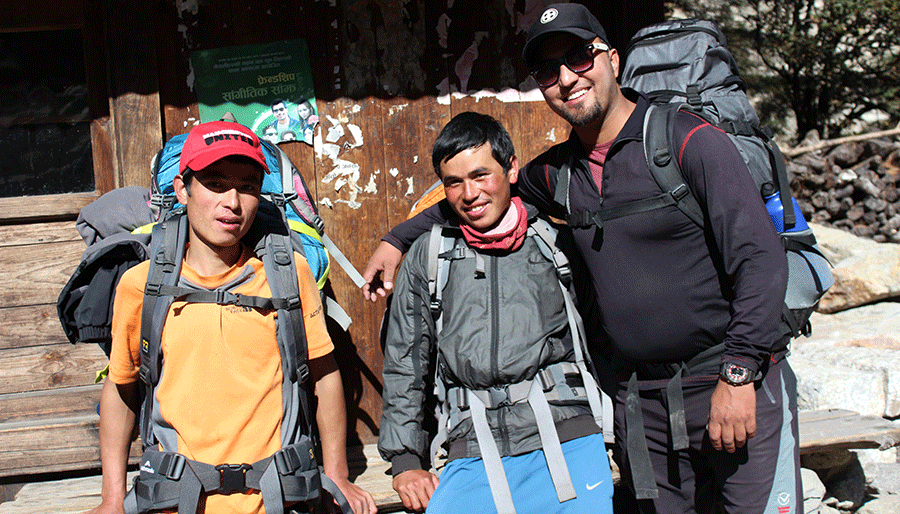May 19, 2022

The Everest Base Camp trek is a popular trek in Nepal that takes you to the base of the world’s highest mountain, Mount Everest. The trek begins in Lukla, a small town in the Solu-Khumbu region of Nepal, and follows the Dudh Kosi river to Namche Bazaar, the gateway to the Khumbu region. From Namche, the trek continues to Tengboche, Dingboche, Lobuche, and Gorak Shep, with a side trip to Kalapatthar for views of Mount Everest and the surrounding peaks. The final destination of the trek is the Everest Base Camp, located at an elevation of 5,364 meters (17,598 feet).
The Everest Base Camp trek is considered to be a moderate to challenging trek, depending on your level of fitness and experience. The trek involves long days of hiking over rough terrain and at high altitudes, and can be physically demanding. It is important to be in good physical condition and to acclimatize properly to reduce the risk of altitude sickness.
The best time to trek to Everest Base Camp depends on your personal preferences and the weather conditions. The trek can be done throughout the year, although the weather is generally most favorable in the spring (March to May) and fall (September to November) seasons.
The cost of the Everest Base Camp trek can vary depending on a number of factors, such as the duration of the trek, the level of accommodation, and the mode of transportation. On average, you can expect to pay around $1,500 to $2,500 for the entire trek, including all meals, accommodation, and transportation.
It is not strictly necessary to hire a guide for the Everest Base Camp trek, as the route is well-marked and relatively easy to follow. However, hiring a guide can be a good idea for several reasons. A guide can provide valuable information about the local culture, flora and fauna, and the history of the region. They can also help you plan you’re itinerary and make sure you are following a safe and appropriate route. A guide can also be helpful in case of emergencies, as they are trained in first aid and can help you get medical attention if necessary.
The Everest Base Camp trek is a popular trek in Nepal and there are several lodges and guesthouses along the route that offer accommodation and meals. It is important to book in advance, especially during peak season, as the lodges can fill up quickly. It is also possible to camp on the trek, but this requires carrying additional gear and supplies and may not be suitable for everyone.
Trekking To Everest Base Camp (12 FAQs)

Where is Mount Everest?
Mount Everest is located between Nepal and Tibet in the eastern part of Nepal.
How tall is Mount Everest in ft. and meters?
Mount Everest is 29,028.87 ft. and 8,848 meters high from Sea level.
Who named Mount Everest?
The Royal Geographic Society successively pronounced the official name “Mount Everest” in 1865 based on the recommendation of Andrew Waugh, the British Surveyor General of India. Sir George Everest was Waugh’s predecessor in the post of Surveyor General.
When is the best time to hike the Everest Base Camp Trek?
Hiking to the base of Mount Everest is best during the autumn season (from mid of September to the end of November) and the spring season (From February to May), however, if you are simply fit, you can trek to the base camp any month of the year with professional Guide.
What is Namche Bazar famous for?
Namche Bazaar is a small town located in the Solu-Khumbu region of Nepal, and it is a popular stop on the Everest Base Camp trek. Namche Bazaar is located at an altitude of 3,440 meters (11,286 feet) and is known for its beautiful location in a bowl-shaped valley surrounded by mountains.
Namche Bazaar is known for its vibrant and bustling atmosphere, and it is a popular place to rest and acclimatize during the trek. The town is filled with a mix of traditional and modern influences, and it is a good place to explore the local culture and shop for souvenirs.
Namche Bazaar is also known for its views of the surrounding mountains, including Mount Everest and the surrounding peaks. The town is located on a ridge above the Dudh Kosi River, and it offers beautiful panoramic views of the surrounding landscape.
Overall, Namche Bazaar is famous for its location, culture, and views, and it is a popular destination for trekkers and travelers visiting the Everest region.
What is the Temperature and weather like during the EBC trek?
The temperature and weather during the Everest Base Camp trek can vary significantly depending on the time of year and the altitude. In general, the weather is warm and sunny during the daytime in the months of September through May, with temperatures ranging from 10 to 20 degrees Celsius (50 to 68 degrees Fahrenheit). The nights can be cold, with temperatures dropping below freezing from November to February.
As you ascend higher in altitude, the temperature will become colder. At the base camp, which is located at an altitude of approximately 5,380 meters (17,600 feet), the temperature can drop below freezing at night and can be quite chilly during the day. It is important to bring warm clothing and a good-quality sleeping bag to stay warm.
The monsoon season in Nepal lasts from June to August, and the weather is generally wet and rainy during this time. The trails can be slippery and muddy, and landslides are more common. It is important to be prepared for wet and unpredictable weather and to bring appropriate clothing and gear.
Overall, it is important to be prepared for changing weather conditions and to bring appropriate clothing and gear for the time of year and the altitude. It is also a good idea to check the forecast before starting your trek and to be prepared for unexpected changes.
Who has climbed Mount Everest the most?
The record for the most ascents of Mount Everest is held by Kami Rita Sherpa, a Nepali mountaineer who has climbed the mountain 24 times as of 2021. Kami Rita began his climbing career as a high-altitude porter and later became a climbing guide. He has climbed Mount Everest from both the south and north sides, and he has also climbed several other 8,000-meter peaks in the Himalayas.
The record for the most ascents of Mount Everest by a woman is held by Lhakpa Sherpa, a Nepali mountaineer who has climbed the mountain nine times as of 2021. Lhakpa began her climbing career as a high-altitude porter and later became a climbing guide. She has climbed Mount Everest from the south side and holds the record for the most ascents of the mountain by a woman.
It is important to note that climbing Mount Everest is a physically demanding and risky endeavor, and not all climbers are able to make multiple ascents of the mountain. These records are a testament to the skill, determination, and endurance of these climbers.
How long is the Everest Base Camp Trek?
The length of the Everest Base Camp trek depends on your itinerary and the pace at which you choose to travel. Most trekking agencies offer trips that range from 12 to 21 days, although it is possible to customize a longer or shorter trip based on your preferences and fitness level.
A typical 12-day itinerary for the Everest Base Camp trek includes a day for travel to and from Lukla, the starting point for the trek, and ten days of trekking to the base camp and back. This itinerary allows for some rest days and time to acclimatize along the way.
A longer itinerary, such as a 21-day trip, allows for more time to acclimatize and to explore the surrounding area, including visits to nearby villages, monasteries, and viewpoints. It also allows for a more relaxed pace and the opportunity to take side trips and detours along the way.
Ultimately, the length of the Everest Base Camp trek depends on your personal preferences and the type of experience you are looking for. It is important to choose an itinerary that is suitable for your fitness level and to allow for flexibility to adjust to the demands of the trek.
How difficult is the Everest Base Camp Trek?

The Everest Base Camp trek is the most visited strenuous trail in Nepal. If you are planning to hike all the way up to the base camp of Mount Everest you should have a good level of Physical fitness.
The Everest base camp trek is a moderate to strenuous type the trek and it is recommended to do during the months of September, October, November, March, April, and May.
What is Khumbu icefall?
The Khumbu Icefall is a treacherous section of the route to the summit of Mount Everest, and it is located on the Southeast Ridge route, which is the most commonly used route to the summit. The Khumbu Icefall is located at an altitude of approximately 5,486 meters (18,000 feet) and is a major obstacle on the route to the summit.
The Khumbu Icefall is formed by the movement of the Khumbu Glacier, which flows down the slopes of Mount Everest. The glacier is constantly moving and calving, and it creates a massive wall of ice and crevasses that must be traversed by climbers. The icefall is prone to avalanches and serac collapses, and it is considered one of the most dangerous sections of the route to the summit.
Climbers must navigate through the Khumbu Icefall using fixed ropes and ladders, and it is a physically demanding and technically challenging task. The icefall is often climbed at night when the ice is more solid and the risk of avalanches is lower.
Overall, the Khumbu Icefall is a formidable and dangerous obstacle on the route to the summit of Mount Everest, and it requires careful planning, skill, and determination to navigate.
How Long Can You Stay on The top of mount Everest?
The amount of time that you can spend on the summit of Mount Everest depends on a variety of factors, including your physical condition, the weather, and the availability of oxygen. The summit of Mount Everest is located at an altitude of 8,848 meters (29,029 feet), and the thin air at this altitude makes it difficult to stay for extended periods of time.
Most climbers spend only a few minutes on the summit to take photos and perform any necessary tasks, such as setting up a GPS unit or changing oxygen bottles. The summit is exposed to strong winds and extreme temperatures, and it is important to stay well-protected and to minimize your time on the summit to reduce the risk of exposure and frostbite.
The average time that climbers spend on the summit is between 15 and 30 minutes, although some climbers have stayed for longer periods of time. The record for the longest time spent on the summit is held by Babu Chiri Sherpa, a Nepali mountaineer who spent 21 hours on the summit in 1999.
Overall, it is important to be mindful of the risks and challenges of staying on the summit of Mount Everest and to plan your time on the summit carefully to ensure your safety and well-being.
Can I trek to Everest Base Camp independently?
It is possible to trek to the Everest Base Camp independently, without the use of a trekking agency or guide. However, it is generally recommended to go with a reputable trekking agency or guide, as they can provide valuable support and assistance with logistics, safety, and local knowledge.
If you do decide to trek to the Everest Base Camp independently, it is important to do thorough research and preparation beforehand, including obtaining all necessary permits and insurance, and to be aware of the risks involved. The Everest Base Camp trek is a physically demanding and remote journey, and it is important to be well-prepared and equipped to ensure your safety and well-being.
Some things to consider when planning an independent trek to the Everest Base Camp include arranging your own transportation and accommodations, carrying your own gear and supplies, and being prepared for unexpected challenges that may arise. It is also a good idea to inform someone of your plans and to carry a satellite phone or other means of communication in case of emergencies.
How much does the Everest Base Camp Trek cost?
The cost of the Everest base camp trek determines on the tour and travel operator you choose and the total time you spend on the mountain. There are several factors varies the price, for example, Hotel standard, Transport, Grade of Guide you are taking,
The cost of The Everest Base Camp Trek varies depending on the tour operator you choose and the length of the trip you book for. The Everest base camp trek cost $1250 US including both-way flight tickets Ktm/Lukla/Ktm. Furthermore, if you are in a group of at least 5 or more than 5 in a group then the price will be cheaper.
You can also find budget tour operators offering the Everest Base Camp Trek for about $999 – $1850.
You are suggested to book your trip with a moderate type of tour operator because budget tour operators provide very basic food, less food, low-quality rooms, and less experienced guide.
Do I need a visa or a permit to hike to Everest Base Camp?
Yes, you need a visa and a permit to hike to the Everest Base Camp. A visa is required to enter Nepal, and a permit is required to enter the Sagarmatha National Park, which includes the Everest Base Camp.
To obtain a visa for Nepal, you can apply for one at your nearest Nepali embassy or consulate, or you can get one on arrival at the airport in Kathmandu. Tourist visas are available for stays of up to 150 days, and they can be obtained for a single entry or multiple entries. The cost of the visa depends on the length of stay and the number of entries, and it can be paid in cash or by credit card.
To obtain a permit to enter the Sagarmatha National Park, you need to apply through a trekking agency or a registered tour operator. The permit fee is currently NPR 3,000 (approx. $30) for foreign nationals, and it is valid for a single entry to the park. You will need to provide a copy of your passport and a recent passport-sized photograph when applying for the permit.
It is important to note that the permit and visa requirements for the Everest Base Camp trek can change, and it is a good idea to check the most current information before planning your trip. It is also a good idea to carry copies of your documents with you during the trek and to keep the originals in a safe place.
What gear do I need to hike to EBC?
There is a wide range of gear that you may need for the Everest Base Camp trek, depending on the time of year and the length of your trip. Some essential items that you should consider bringing include:
Warm clothing: The weather in the Everest region can be cold, especially at high altitudes, and it is important to bring warm clothing to protect against the elements. This includes items such as thermal underwear, a down jacket, fleece layers, a waterproof shell jacket, and a warm hat, gloves, and socks.
Hiking boots: A good pair of hiking boots is essential for the trek, as you will be walking on uneven terrain for several hours each day. Choose a pair that is comfortable, well-fitted, and appropriate for the conditions.
Sleeping bag: A good-quality sleeping bag is important to stay warm at night, as temperatures can drop below freezing at high altitudes. Choose a bag that is rated for cold temperatures and that is suitable for the time of year you will be trekking.
Backpack: A backpack is essential for carrying your gear and supplies during the trek. Choose a backpack that is large enough to hold all your essentials and that is comfortable to carry.
Water bottle: It is important to stay hydrated during the trek, and a water bottle or hydration system is essential for carrying water.
Headlamp: A headlamp is useful for navigating in the dark and for doing tasks in your tent or guesthouse.
First aid kit: A basic first aid kit should include items such as bandages, painkillers, and medications for common ailments such as diarrhea and altitude sickness.
Sun protection: The sun can be strong at high altitudes, and it is important to protect your skin with sunscreen, sunglasses, and a hat.
There are many other items that you may need for the trek, depending on your personal preferences and the specific conditions. It is a good idea to do thorough research and consult with a reputable trekking agency or guide to ensure that you have all the necessary gear and supplies.

If you forget to buy this gear in Kathmandu then no worries once you land in Lukla there will be shop stores to buy and also in Namche Bazar. Actually, there will be quite some choices ta Namche Bazar.
Is There a proper Everest Guide for the EBC trek or i can hire any other authorized guide?
No, there are quite some guides, who work in almost all trekking regions in Nepal. There is no proper guide who just works in the Everest region. if you are trekking to EBC you can hire a Guide from Kathmandu or Lukla but License Holder Guide.
How much should I pay for the guide and porter?

There are many factors and the standard of travel agencies determines the price, But the moderate types salary a day for a Guide is between 30-35 USD, similarly 25-30 USD for a porter. in Nepal, there is not really a fixed rate for them but the price above is the approximate salary a day for them.
Are there locks on our doors at Hotel?
In the Everest region, nowadays there is quite lovely tea house accommodation and they provide a key to lock your door. incase if there is no locking key at your door, on request they will give the key.
Are there ATMs Machines available?
There are a limited number of ATMs available along the Everest Base Camp trek, and they are not always reliable. Many trekkers choose to bring cash in small denominations to cover expenses such as meals, accommodation, and any additional costs that may arise. It is a good idea to bring enough cash to cover your needs for the duration of the trek, as it may be difficult to access additional funds if the ATMs are not working.
Keep in mind that the availability of ATMs can vary depending on the season and the region, and it is a good idea to plan ahead and bring enough cash to cover your needs. It is also a good idea to inform your bank and credit card company of your travel plans, as they may place a hold on your account if they see unusual activity.
Overall, it is a good idea to be prepared for the possibility of not having access to ATMs and to bring enough cash to cover your needs during the trek.
What foods should I eat during the EBC trek?
The type of food that you eat during the Everest Base Camp trek will depend on your personal preferences and dietary needs. It is important to fuel your body with nutritious and energizing foods to help you sustain the physical demands of the trek. Here are some food options to consider:
Carbohydrates: Carbohydrates are an important source of energy for trekking, and they can help you maintain your energy levels and performance. Good sources of carbohydrates include rice, pasta, noodles, bread, potatoes, and oats.
Protein: Protein is important for muscle recovery and repair, and it can help you maintain your strength and endurance during the trek. Good sources of protein include meat, poultry, fish, tofu, beans, and nuts.
Fruits and vegetables: Fruits and vegetables are a good source of vitamins, minerals, and antioxidants, and they can help you stay healthy and energized during the trek. Choose a variety of fresh and dried fruits and vegetables to include in your meals.
Fats: Fats are an important source of energy, and they can help you stay warm and satisfied during the trek. Good sources of fat include nuts, seeds, avocados, and olive oil.
It is a good idea to choose foods that are easy to digest and that are high in calories to help sustain your energy levels. It is also important to stay hydrated by drinking plenty of water and carrying snacks such as energy bars.
Who Was the First Indian to Climb Mount Everest?
The first Indian to climb Mount Everest was Bachendri Pal, who reached the summit on May 23, 1984. Bachendri Pal is a well-known mountaineer and is credited with inspiring many Indians to take up mountaineering.
Bachendri Pal was born in 1954 in the village of Nakuri in the state of Uttarakhand, India. She began her climbing career in 1979, and she has climbed several other peaks in the Himalayas, including Nanda Devi, Trishul, and Kamet.
In 1984, Bachendri Pal became the first Indian woman to reach the summit of Mount Everest, and she also became the first woman in the world to have climbed the mountain from the northern side. She has received numerous awards and accolades for her achievements, including the Padma Shri, one of India’s highest civilian honors.
Overall, Bachendri Pal is a pioneer and role model for Indian mountaineers, and she is recognized as one of the most accomplished climbers in the country.